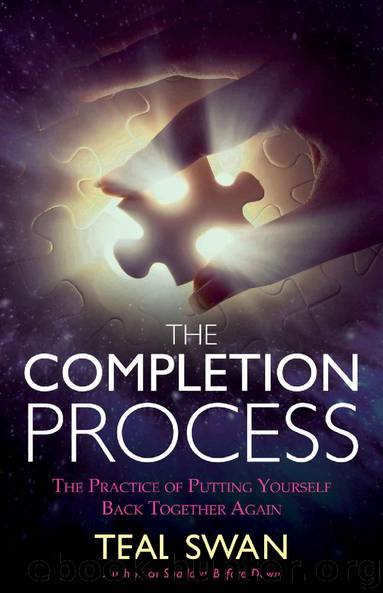The Completion Process: The Practice of Putting Yourself Back Together Again by Teal Swan

Author:Teal Swan [Swan, Teal]
Language: eng
Format: epub
Publisher: Hay House, Inc.
Published: 2016-08-22T22:00:00+00:00
Basically, any words that help you to complete this first level of validation are worth saying and repeating because they will help you stay calm and focused. The reality is that the feeling is valid, it is there for a reason, it has meaning, and it is part of you. That is why it is so important for you to validate it to yourself.
STEP 4: INVITE THE MEMORY TO SURFACE.
In this step, use the sensations of the “feeling flavor” as if they were a rope connecting you to the origin or causation of that very feeling. Ask yourself: “When was the first time I felt this feeling?” Instead of mentally chasing the answer, let your being offer it up to you, like a bubble floating up from the depths of the ocean.
We don’t need to conceptually re-experience full memories to integrate an aspect of ourselves that is frozen in the past. Sometimes just being with a feeling enables us to integrate the emotional charge of a memory, which might be the only part that is frozen or stuck. The actual memory never surfaces. If we only need emotional integration, a tangible memory is unlikely to come.
If we become consciously aware of an actual memory, we are meant to gain wisdom from mentally re-experiencing and interacting with it. In other words, we are meant to become aware of that memory because, in doing so, we are assisted in our current development. Often the mind and the emotion both are in need of healing and integration. When this is the case, memories surface as a result of asking the question, “When was the first time I felt this exact feeling?” Another way to approach this is to ask the feeling itself (as if it were a separate being): “When was the first time I felt you?”
Keep in mind that we have a limited view of memory. We rely on the visual aspect of our lives so heavily that we forget that there are many different kinds of memory. Our bodies can remember sensations, smells, sounds, or feelings. So just because you don’t “see” anything, doesn’t mean you aren’t getting back a memory. Also, because we were feeling beings instead of thinking beings when we were very young, some of the earliest memories we have consist of only emotional or sensation memory.
For example, a person who is recalling a memory in the womb of a mother who didn’t want the pregnancy will often not see anything. Instead, she might have an intense, all-consuming feeling of being stuck and unwanted.
It’s tempting when we want to understand why we feel the way we feel to try to rush this process. We might try to go looking for the memory mentally, but doing it this way, we tend to get ourselves off track. Instead, I recommend that you learn to take a backseat and treat the inside of your body as if it were a movie screen. Simply wait, watch, and feel for what shows up on its own.
Download
This site does not store any files on its server. We only index and link to content provided by other sites. Please contact the content providers to delete copyright contents if any and email us, we'll remove relevant links or contents immediately.
Daring Greatly by Brene Brown(6375)
You Do You by Sarah Knight(4398)
The Confidence Code by Katty Kay(4166)
Ikigai by Héctor García & Francesc Miralles(4052)
He's Just Not That Into You by Greg Behrendt & Liz Tuccillo(3813)
The Courage to Be Disliked by Ichiro Kishimi & Fumitake Koga(3356)
Toxic Parents by Susan Forward(3175)
Make Your Bed by William H. Mcraven(3062)
Self-Esteem by Matthew McKay & Patrick Fanning(3042)
365 Days of Wonder by R.J. Palacio(2720)
The Gaslight Effect by Dr. Robin Stern(2714)
The Gifts of Imperfection by Brene Brown(2476)
Dare to Lead by Brené Brown(2367)
The Charisma Myth: How Anyone Can Master the Art and Science of Personal Magnetism by Cabane Olivia Fox(2347)
The Modern Alpha Male: Authentic Principles to Become the Man You Were Born to Be: Attract Women, Win Friends, Increase Confidence, Gain Charisma, Master Leadership, and Dominate Life - Dating Advice by Patrick King(2273)
How to Own Your Own Mind by Napoleon Hill(2215)
Parisian Charm School by Jamie Cat Callan(2208)
The Year of the Introvert by Michaela Chung(2173)
How to Make Small Talk by Melissa Wadsworth(2163)
